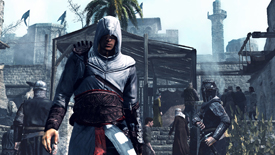
An old adage goes, “If it ain’t broke, don’t fix it.” Publisher and developer Ubisoft has taken that saying and thrown it out the window.
While Ubisoft would have made plenty of money repackaging its 2007 title Assassin’s Creed with a new story, it has gone above and beyond, improving almost every facet of the original game in Assassin’s Creed II.
Assassin’s Creed II takes place right where the original left off. Protagonist Desmond Miles gives a quick recap explaining his experience with a company called Abstergo that forced him to relive the memories of his ancestor Altaïr Ibn La’Ahad, an assassin during the Crusades, on a machine called the Animus. Desmond finds he is in way over his head as he becomes part of a secret war between two clans: the Assassins and the Templars.
Breaking out of Abstergo with laboratory assistant Lucy, Miles is trained by a team of Assassins. To do learn the skills of the trade, they have him relive the life of another one of his ancestors, Ezio Auditore de Firenze, an Italian assassin in the 15th century who is out to avenge the deaths of his father and two brothers. A “bleeding effect” should cause Desmond to learn all that Ezio learns as he trains to be an assassin while experiencing Ezio’s life in the Animus 2.0. Also, Ezio has to hone his skills as he escapes the wrath of a corrupt politician with a grudge against his family and learns the secrets his father left behind — those of his double life as an assassin.
There are so many improvements to the sequel that it’s hard to choose where to start. The story is more action-packed and interesting this time around, perhaps due to the fact they did not need to introduce us to the science of the Animus. Players are immediately immersed in the action. Game play has improved considerably — the missions are no longer repetitive, as they were in the original game. Assassin’s Creed had only a handful of tasks, while there are about 10 more mission styles in the sequel.
Also added to Assassin’s Creed II is the ability to purchase merchandise from vendors to upgrade Ezio’s weapons and armor. Weapons can also be stolen from opponents and used against them. Renaissance man Leonardo da Vinci acts as the arms dealer, designing Ezio’s trademark wrist blades, a flying machine and other tools to carry out missions and assassinations, while other historical figures such as famous banker Lorenzo de’ Medici make appearances.
The artificial intelligence has improved greatly, with smarter, tougher guards and enemies who search in more hiding spaces when they come after you.
In addition, the Animus 2.0 has several welcome additions. When Desmond is reliving Ezio’s life, he is supplied with historical information about the famous locations in Italy he passes, as well as biographies of characters in the game, fitting them into both Europe’s and the game’s history. Documents such as letters from one character to another also deepen the experience and often have full voice-overs reading them — an impressive feature that makes these documents more engaging.
Ezio is also a more dynamic character than the original’s assassin, Altaïr. He is more personable than his focused and somber ancestor. Further, this game takes place over the course of many years so players see Ezio age and change, making the story more interesting. Desmond has grown, as well. The introverted bartender turned science project turned assassin has come out of his shell quite a bit.
The controls, mostly unchanged from the original, which great for the fluid rooftop parkour involved in escaping enemies around Florence, Venice, Tuscany and Rome. Unfortunately, this is one area with a flaw. The controls can be too sensitive when one is trying to make jumps in the rafters of a church and hoping not to fall to his death. One wrong twitch of a finger can lead to restarting a mission at the last checkpoint.
Text on the screen tends to be on the small side, making it difficult to read mission instructions and subtitles for the voice acting.
Sequels tend to be more of the same, with just a few extra features thrown in. The original Assassin’s Creed was popular despite its flaws, and Ubisoft would have sold plenty of copies simply following the typical sequel formula. However, it went above and beyond, making almost everything about Assassin’s Creed II better than the original. Skeptics can breathe easy — this is one of the most impressive experiences you can have on your Xbox 360 or Playstation 3 this holiday season.
diversions@umdbk.com
Rating: 4.5 stars out of 5



